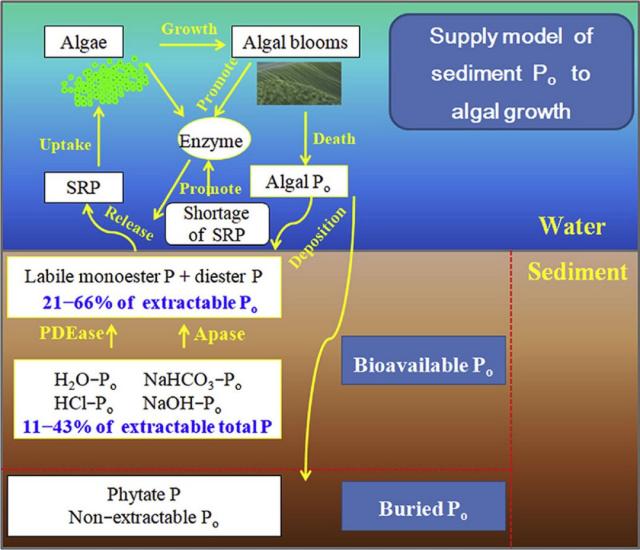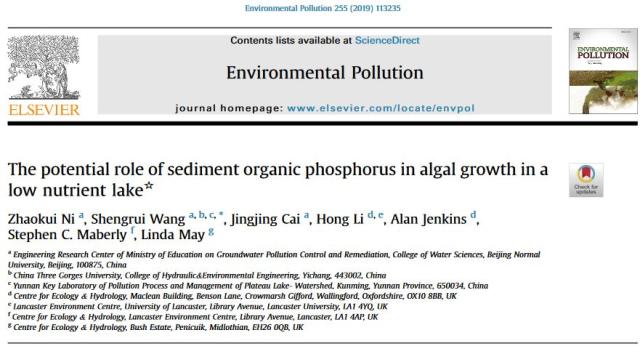北京师范大学水科学研究院王圣瑞教授团队探讨了沉积物中的磷对内源磷储存的相对重要性以及生物可利用性磷在洱海藻类生长中的作用。结果发表于Environmental Pollution(IF=5.714)。
Highlights
Role and supply model of sediment bioavailable Po in algal growth was studied.
The potential releasing risk of Erhai sediment bioavailable Po is great.
DOM structure, microorganism activity and algae biomass are responsible for bioavailable Po environmental processes.
Bioavailable Po replenishes available P pools in overlying water to facilitate algal growth.
Abstract
The role of sediment–bound organic phosphorus (Po) as an additional nutrient source is a component of internal P budgets in lake system that is usually neglected. Here we examined the relative importance of sediment Po to internal P load and the role of bioavailable Po in algal growth in Lake Erhai, China. Lake Erhai sediment extractable Po accounted for 11–43% (27% average) of extractable total P, and bioavailable Po accounted for 21–66% (40%) of Po. The massive storage of bioavailable Po represents an important form of available P, essential to internal loads. The bioavailable Po includes mainnly labile monoester P and diester P was identified in the sequential extractions by H2O, NaHCO3, NaOH, and HCl. 40% of H2OPo, 39% of NaHCO3Po, 43% of NaOHPo, and 56% of HClPo can be hydrolyzed to labile monoester and diester P, suggesting that the bioavailability of Po fractions was in decreasing order as follows: HClPo>NaOHPo>H2OPo>NaHCO3Po. It is implied that traditional sequential fractionation of Po might overestimate the availability of labile Po in sediments. Furthermore, analysis of the environmental processes of bioavailable Po showed that the stabler structure of dissloved organic matter (DOM) alleviated the degradation and release of diester P, abundant alkaline phosphatase due to higher algal biomass promoted the degradation of diester P. The stability of DOM structure and the degradation of diester P might responsible for the spatial differences of labile monoester P. The biogeochemical cycle of bioavailable Po replenishs available P pools in overlying water and further facilitate algal growth during the algal blooms. Therefore, to control the algal blooms in Lake Erhai, an effective action is urgently required to reduce the accumulation of Po in sediments and interrupt the supply cycle of bioavailable Po to algal growth.
沉积物结合态有机磷(Po)作为额外的营养源,是湖泊系统内部磷平衡的一个组成部分,但常被忽视。本文探讨了沉积物中的磷对内源磷储存的相对重要性以及生物可利用性磷在中国洱海藻类生长中的作用。洱海沉积物可提取的Po占可提取总P的11%-43%(平均值为27%),生物可利用性Po占可提取总P的21%-66%(平均值为40%)。生物可利用性Po的大量储存是有效磷的一种重要形式,对内源磷储存至关重要。生物可利用性Po主要包括不稳定单酯P和二酯P,由H2O、NaHCO3、NaOH和HCl依次提取。40%的H2OPo、39%的NaHCO3Po、43%的NaOHPo和56%的HClPo可以水解为不稳定的单酯和二酯P,表明Po的生物可利用性顺序为: HClPo >NaOHPo >H2OPo >NaHCO3Po。这意味着传统的连续分馏方法可能高估了沉积物中不稳定Po的有效性。此外,对生物有效态有机质(Po)的环境过程分析表明,降解有机质(DOM)结构的稳定减轻了二酯P的降解和释放,而藻类生物量的增加所产生的丰富的碱性磷酸酶促进了二酯P的降解。DOM结构的稳定性和双酯P的降解可能是造成不稳定单酯P空间分布差异性的原因。生物有效磷的生物地球化学循环补充了上覆水体中的有效磷,并在藻华期间进一步促进了藻类的生长。因此,控制洱海藻华,迫切需要采取有效措施减少沉积物中Po的积累,阻断生物可利用性Po对藻类生长的供给循环。
本文转自:农业环境科学


